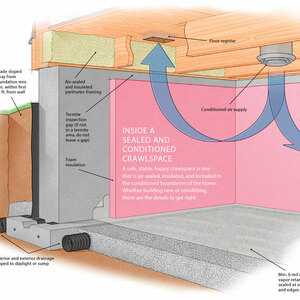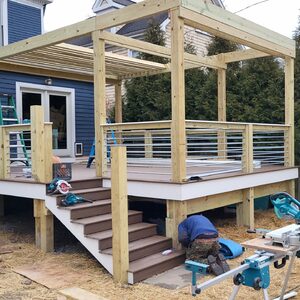This post was originally blocked by our dear friend Mollum. Details below.
Discussion Forum
Discussion Forum
Up Next
Video Shorts
Featured Story

There's a constant source of clean water for you to use, and all you have to do is collect it.
Featured Video
How to Install Exterior Window TrimHighlights
"I have learned so much thanks to the searchable articles on the FHB website. I can confidently say that I expect to be a life-long subscriber." - M.K.

















Replies
Enter the text into a word processor, screen capture the word processor screen, then post the image.
Did that. Bummer, no change.
I included a bunch of acronyms about wire types.. NMD, NMWU, SJOW, etc. Might have sparked a few of Mollum's hormones?
I don't believe they're scanning images -- the software's far too unsophisticated for that. I'm guessing there's something wrong with your ID, or maybe the title you're using for the post.
Weird... I've tried different titles and with and without images, different forums, no go.
I'll see if I can post it as a reply in this thread.
I thought I knew the residential code fairly well, but I gotta admit to some stumpage on this one.
I've got a suspended galvanized cable, tensioned with turnbuckles that runs to our woodshed. Hung from the cable is a #12 SJOW extension cord that I plug into a receptacle.
I'm about to buy an electric wood splitter which isn't recommended for use with extension cords longer than 25 feet, so I'd like to replace this setup with solid #12 wire.
Does the code (or industry standards) indicate anything about wire exposed to the elements this way? I'm thinking about using NMWU.
Does it address how it's to be hung from the cable?
Does it address how terminations are to be done? I'll no longer be plugging it into a recep. It will be run into the box and connected with wire nuts.
Any other issues you can think of?
Thanks.
For the purposes of voltage drop a cord is going to look about like a cable. If the distanbce bothers you, go with a bigger wire size.
>>>For the purposes of
>>>For the purposes of voltage drop a cord is going to look about like a cable. If the distanbce bothers you, go with a bigger wire size.
Really? I always figured solid was better than stranded, but I'll admit I haven't done much reading on it.
I just figured that because you always see guidelines about extension cord limits, but rarely see guidelines about branch circuit limits, hence solid was better.
How about the plug versus wirenut connections. Would you concern yourself with that?
For a given wire size, solid and stranded carry the same current, within "engineering accuracy". Solid is used in house wire mostly because it's cheaper and because it's easier to form a loop around a terminal with it (without the problem of loose strands shorting out).
How long is the cable going to be, end to end? What is the current rating of the wood splitter?
Note that whatever you do will probably not be code-compliant, but will hopefully be better than the extension cord.
>>>How long is the cable
>>>How long is the cable going to be, end to end? What is the current rating of the wood splitter?
Including #14 branch circuit wiring? I'm going on memory here, but I'd guess that the #14 (interior portion) is about 50' which takes it to the exterior box. Then it's about a 70' run to the woodshed, which I plan to do with #12.
>>>Note that whatever you do will probably not be code-compliant, but will hopefully be better than the extension cord.
Zackly. But what surprises me is that our residential code (as far as I know, and I read it from cover to cover) is silent on suspension methods and terminations. Does your residential code adress this?
I'm guessing the electrical code has something to say about suspension, but I'm too lazy to drag out the book and try to decipher it.
But... What's the current rating on the splitter????
>>>But... What's the current
>>>But... What's the current rating on the splitter???
Sorry, forgot you asked that.
It's pinned right at the max, which in our jurisdiction is 15A @ 120V, and the manual cautions against extension cord use. Pictures I've seen make it look like a drip proof induction motor.
I split a lot of wood, and would like this unit to last some years, so if it takes me an afternoon to "do it right" I'm perfectly willing to do so.
If you ran #12 the entire 120 feet you'd have 8.4V voltage drop, which is right on the hairy edge of acceptable. Given that nearly half is pegged at #14, I'd suggest you run #10 the rest of the way, to keep voltage drop as low as possible. (Ideally it should be #8 the whole way, but with the #14 in the mix that's pointless.)
(A response is "queued for
(A response is "queued for moderation". Apparently "voltage drop" is considered subversive.)
If this has a NEMA 5-15 (regular) plug on it I bet the FLA is 13a. That should be OK on 70' of cord. What is your line voltage to start with? Mine is 123v at the mains so I have more wiggle room.
>>>If this has a NEMA 5-15
>>>If this has a NEMA 5-15 (regular) plug on it I bet the FLA is 13a. That should be OK on 70' of cord. What is your line voltage to start with? Mine is 123v at the mains so I have more wiggle room.
Last I checked, which was a while ago, it hovered around 118V.
Suspended Wire
I thought I knew the residential code fairly well, but I gotta admit to some stumpage on this one.
I've got a suspended galvanized cable, tensioned with turnbuckles that runs to our woodshed. Hung from the cable is a #12 SJOW extension cord that I plug into a receptacle.
I'm about to buy an electric wood splitter which isn't recommended for use with extension cords longer than 25 feet, so I'd like to replace this setup with solid #12 wire.
Does the code (or industry standards) indicate anything about wire exposed to the elements this way? I'm thinking about using NMWU.
Does it address how it's to be hung from the cable?
Does it address how terminations are to be done? I'll no longer be plugging it into a recep. It will be run into the box and connected with wire nuts.
Any other issues you can think of?
Thanks.
Queued for moderation..... maybe it will apprear later.
It appears to have appeared.
But since he's starting out at 118V (and this is a motor load) he needs to minimize voltage drop as much as possible. He should use 12 or 10 for the remainder of the (relatively long) run.
Thanks for all of this guys, I'll keep it in mind. But it's looking like it's going to be an academic issue for yet another year. I decided to buy an ATV for plowing snow this winter (among other things), so as a result I'll be swinging the maul for another Winter.
In the meantime, I'm off exploring the mountains with the kids!!!